


VOL. II NO. 45 REG NO. L5015 DELHI, THURSDAY JULY 20, 1944.
|
|
IN MYITKYINA AREA |
NORTHERN BURMA - Allied Forces under Lt. Gen. Joseph W. Stilwell have achieved satisfactory gains at Myitkyina during the past week and military correspondents predict that the struggle for this key position will soon enter its final phase.
Chinese ground troops, supported by medium bombers of the USAAF, advanced nearly half a mile in
|
It is reported that many of the Japs captured or killed at Myitkyina were found with white skin from being underground for days without proper diet.
In the Mogaung-Kamaing area, Chinese troops and Nigerians of the Chindit units captured the village of Pyindaw, eight miles west of Mogaung. Chinese troops captured the village of Sumkrung, 10 miles southwest of Mogaung.
Gurkha troops and Kachin Levies, operating out of Fort Hertz, attacked and occupied Jap positions on the south bank of the Nsop River near Nsopzup.
L-5 LIAISON PLANES HURDLE THE HUMP
|
CHINA - They said it couldn't be done . . . so, thus challenged, two pilots of the 14th Air Force proceeded to do it.
Ever since the war's start, flying The Hump has been one of the bugaboos of aviation. Even the pilots of the C-47's, C-46 Commando's and four-engined bombers never start the hazardous hop over the snow-clad Himalayas without figuratively knocking on wood.
And here were two brash young 14th Air Force officers - Maj. Fred G. Welsh, of West Englewood, N.J., and Capt. Edward F. Maher, of St. Louis - announcing audaciously they were going to fly from a base in Assam to an advanced base in China in a pair of tiny L-5 Stinson liaison planes.
Grizzled veterans shook their heads. "Don't be silly," they warned. "You can't do it, it's tough enough in a twin-engined job, but in one of those fluttering fleas? Betcha five to two you don't make it.
"It would have been a good bet," grinned Welsh after landing successfully in China. "If we'd lost, we wouldn't have been able to pay anyway."
In spite of the well-intentioned warnings, Welsh, a P-40 pilot, and Maher, who spends most of his time with B-25's, gassed their tiny two-seated aircraft, tacked on auxiliary tanks and warmed up their 180 horsepower Lycoming engines. They knew how much time the flight would consume, at their estimated top speed of 100 miles per hour at that altitude. They also knew that the regular tanks carried only enough gas to give them a cruising range of about four hours.
nevertheless, at 10 o'clock in the morning, the two planes skittered into the sky, while veteran Hump-hoppers shook their heads dolefully.
"There go two good guys," they reflected sadly. "Too bad."
Let Welsh tell the story:-
"We make a normal take-off," he said. "We had no instruments to speak of and our radio, such as it was, was inoperative. In other words, we flew by the seat of our pants just as the old time barnstormers used to do. Of course, we had made a thorough check through China National Aviation Corporation and Air Transport Command and we knew the lowest spots, the passes to hit.
"We got as high as we could, around 9,000 feet, and negotiated most of the passes. We had to drop almost to the ground at times; sometimes as low as 300 feet, skimming the tree-tops. Many times we had to circle until the clouds lifted. Maher flying on my right. We flew low across the steaming jungle... once we frightened a herd of wild elephants. We flew low, so the Japs couldn't get under us with their ground fire.
"I was only worried once," smiled Welsh. "We were going through the main pass and the air was plenty bumpy. I climbed to 9,500 and Maher went to 10,000 on my right wing. There were local thunder showers and we were getting pushed around plenty.
"I dropped close to the ground to get out of it and was cloud-covered. When I came out, I could see the Salween close at hand, but I couldn't see Maher. I circled for 10 minutes, my gas getting lower all the time. I could see groups of Jap patrols, nut no Maher. Boy, I sweated! I was almost glad we hadn't taken the bet!
"Suddenly, Maher broke through a cloud. He had picked up some ice, but was all right again. I waved at him, and off we went.
We hit for the pass. It was so narrow we had to fly single file through.
"Well, we broke through in the clear. I breathed easier and I know Maher did, too."
|
|
British Mop Up On Ukhrul Road
KANDY - Climaxing a week of steady progress following the capture of Ukhrul, troops of the Fifth Royal Gurkha Rifles have captured other Jap strongpoints, the villages of Ningthoukhong and Kha Chunou, five miles south of Bishenpur, announced SEAC.
Japanese defense of the towns was negligible, the defenses having been battered by air and artillery bombardment.
Mopping up has been completed in Ukhrul village and along the Imphal-Ukhrul road. Several large Jap units have been surrounded in this area and their escape route cut off by blocking the track to the Chindwin.
Miracle
|
PRESSURIZATION IN SUPER-FORTS
By WALTER G. RUNDLE United Press Correspondent
20TH BOMBER COMMAND HEADQUARTERS, INDIA - The thermometer above your head registers an outside temperature of 12 degrees below zero. The altimeter on the instrument panel reads 24,000 feet. Below you lie the jagged, snowcapped peaks of the Himalayas. You're flying The Hump, and in the nose of a giant B-29 Super-Fortress you're comfortable in summer suntans, with your sleeves rolled up in spite of the bitter temperature outside and you smoke, unencumbered by an oxygen mask and heedless of oxygen-thin air of the substratosphere in which a man could live scant minutes. You converse normally with others on the flight deck without microphone or earphones, unmindful of the thunder of four huge 2,200-horsepower engines.
Among the men who fly the Super-Forts there's a new word for this miracle of comfortable high-altitude flight - a word which will have vast meaning to civilian air travel after the war. That word is "pressurization."
DAWN TAKE-OFF
You took off in the first light of sawn from one of the new secret American airbases in China. As you left the valleys and rolling hills of China behind and began the climb over the Hump to India, the pilot told the crew over the intercom, "We're going upstairs now. I'm pressurizing."
Behind you the radio operator closed and sealed a big circular bulkhead and back in the gunner's compartment another bulkhead was dogged down against the cold, thin air. The engineer flipped a switch and somewhere back in the ship there was the almost inaudible whirr of a motor. Otherwise, there was no consciousness off the processes making possible comfortable, sub-stratosphere flight.
WEATHER FRONT
Up ahead the weather map shows a massive weather front, towering upward 23,000 feet. To the cargo planes flying The Hump, that means rough going with crews shivering in the bitter cold, even though bundled up in their warmest clothing. It also means reliance on oxygen masks over a large part of the route. But to the high-flying, pressurized B-29 it poses no problems, imposes no discomforts.
The value of pressurization in combat is the freedom of pilots and crews from hampering heated clothing, cumbersome jackets and gloves and the assurance of a constant ample and uninterrupted supply of oxygen at high altitude without the burden of oxygen masks. Combat experience has proved that pressure can be maintained even after a dozen or more bullets have punctured the pressurized cabins.
To post-war civilian travelers pressurization offers the prospect of flying comfortably in the smooth air of the substratosphere well above the weather while the greater speeds obtained at higher altitudes will make it possible to breakfast in New York and have luncheon in Los Angeles.
10TH AIR FORCE MOVES CLOSER TO AIR FRONT
Headquarters of the 10th Air Force, once again an independent striking arm, has moved to
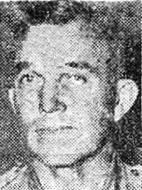
|
This announcement, made by Maj. Gen. George E. Stratemeyer, EACissimo, also revealed that Maj. Gen. Howard C. Davidson has relinquished his post as Commander, Strategic Air Force, EAC, to direct operations of the 10th Air Force.
Davidson's Strategic Air Force Command duties have been assigned to Air Commodore F. J. W. Mellersh, World War I fighter pilot who fought in the engagement during which German ace Von Richtofen was shot down. Mellersh commanded a bomber station in England before moving to the Far East, where he has served in Delhi and Ceylon.
The move of the 10th Air Force Headquarters places it 1,500 miles closer to the Indo-Burma air front, shortening the lines of communications with fighting units to a marked degree.
Despite the handicap of the monsoons, the transfer was carried out according to schedule.
Bungalows which once housed tea plantation managers and superintendents are now offices. A limited few bamboo bashas have been converted into quarters, but most of the officers and enlisted men live in tents.
HISTORICAL CBI BOOK TO GO ON SALE SOON
INDIA - A complete book on the Chinese-American training center entitled Now It Can Be Told, is available to service personnel at a cost of Rs. 10, and an additional Re. 1 will send it home.
The book is completely illustrated. It can be obtained by sending the money to Special Service Office, APO 628 (Ramgarh, India).
TWO RADIO STATIONS BEAMED TOWARD CBI
The CBI Theater will have access to American radio programs direct over short-wave sets, according to plans announced in Washington this week by the Federal Telephone and Radio Corp.
The plan is to set up two short-wave stations on the West Coast. These stations, to be operated under the auspices of OWI, will be twice as powerful as any existing transmitters in the U.S. and are expected to cover the area from Siberia to India, and the entire Pacific.
The Government hopes these stations will counter Jap-originated broadcasts, which are the only satisfactorily received programs now in many Pacific and Far East areas.
The equipment is being tested and officials hope to have the stations operating by fall.
18,000 PATIENTS FLOWN BY EVACUATION UNIT
Armstrong Commends Amazing Record of Medical Outfit
|
Serving aboard C-47's loaned and flown by the ATC, flight surgeons, nurses and enlisted technicians of the unit, which is commanded by Maj. Morris Kaplan, shuttle from their India base to the crude airstrips of North Burma, bringing out the wounded and sick. A Chinese or American soldier wounded this afternoon in the Mogaung Valley fighting, may be resting comfortably before nightfall in one of the various hospitals in the rear area.
The job is a risky one. Pilots fly hospital ships into the teeth of fierce monsoon weather to get into the forward fields, knowing they cannot afford to wait for clearing skies when there are wounded to be brought out. Jap ground fire has been encountered more than once. At Myitkyina, the squadron was operating soon after the airfield was seized, while the area was still under Jap fire. Here Chief Nurse Audrey E. Rogers became the first American woman in Burma to earn the Purple Heart award when she was wounded in the leg by bomb fragments while loading a plane.
On another occasion, a hospital ship, delayed by tropical storms, arrived after dark back at its India base and began searching for the landing strip, which lacked night lights. Pfc. Robert McFarlin then had an idea. Two ambulances went racing to either end of the field, parked, and turned on their headlights as markers for the runway, on which the grateful pilot soon afterwards set down his big ship with its precious load.
Another CBI unit has also done brilliant work in casualty evacuation. Pilots of a liaison squadron, commanded by Capt. Ned Epps, were jockeying their little Piper Cubs into short, rough strips and even unprepared jungle clearings to bring out wounded in the days before fields were available for transports in the combat area. Today they are continuing their exploits in places inaccessible to the bigger planes, and the tales of their daring landings and take-offs have become Burma legends.
G.I. CABBY TAKES JAP FOR LEDO ROAD RIDE
LEDO ROAD - T/Sgt. Milton Brady stopped his truck at an M.P. post along the Ledo Road and nonchalantly waited for the check-up of his Kachin passengers.
But his poise was badly shaken when a Chinese officer reached in, grabbed one of the "natives," and pulled him out.
"He's a Jap," the officer pointed out to Brady.
Brady has had few dull moments along the Road as non-com in charge of a Negro Signal Corps Construction Battalion but that was the highlight of his career.
"How was I to know?" he pleaded, "The Jap was dressed like a Kachin."
Whenever this incident is brought up, Brady launches into the Munchausen activity of one Pvt. Everett E. Williams.
Seems Williams was hacking through a bamboo grove when a reptile fell on him. Williams let out a cry that he was being attacked by a "snake, 55 feet long."
"The snake was only five feet long and I killed it myself with a machete," says Brady, hoping by this time his listener has forgotten about the time he gave a lift to a Jap.
|
NAMED BY JAPS OVER RADIO
10TH AIR FORCE BASE - Ever since it started winning a reputation for itself by knocking down Japanese planes over Burma, one of the crack P-51 (Mustang) fighter-bomber squadron of the 10th USAAF, Eastern Air Command, has been seeking a suitable nickname, but without notable results.
Then one evening suddenly out of the thin air, it got it's nickname - "Yellow Scorpions" - and, from all people, the Japanese themselves.
Commanded by Maj. Sydney Newcomb, of Green Village, N.J., the squadron has 50 enemy planes confirmed.
At the start of their operations, "Sid's Kids," whose planes are distinguished by yellow-painted noses, won victories in the skies only one or two at a time. Their foes were the famous "Black Dragons," the crack front line Japanese Navy pilots from the South Pacific, who were sent to Burma for a "rest."
SENSATIONAL RECORD
A few battles and the Americans obtained the experience they needed to weld them into a great fighting team.
Recently, Newcomb's outfit tangled with the Japs again over Central Burma, and the result was one of the most remarkable of the entire war. The Yanks, in one scrap, bagged 13 planes confirmed, without suffering so much as ONE bullet hole in any of their planes.
The next day, "Sid's Kids" destroyed eight more Japanese planes in the air, and, excepting for a few holes in a couple of the ships, no damage was suffered. The day after that, they again found the enemy, this time getting four more, all without the loss of a plane. The score thus was 25 Japanese planes confirmed as destroyed, with several more listed as probably destroyed and many more damaged, against no losses for our side.
BOAST UNFULFILLED
Only a few days after the third melee, members of the squadron heard a Japanese broadcast reporting that it was coming over to "annihilate the 'Yellow Scorpion' squadron," but no one knew which outfit the Japs meant. A few days later, the Japs again broadcast the same warning, but this time identified the squadron by its location. Neither time did the Japs fulfill their threat. They never even came over when they said they would, nor did they make an attempt at a subsequent date.
But the broadcasts did serve the Americans a good turn. It gave the squadron a nickname. They've adopted the nickname, "Yellow Scorpions."
|
INDEPENDENCE, MO. - (ANS) - The telephone in the residence of Mrs. Wanda Holzbaur here rang the other night and the voice said, "This is Henry Wallace, calling from Washington."
It was the Vice-President in person.
During his recent visit to the China neck of CBI, Wallace had visited Sgt. George H. Holzbaur, Jr., a B-29 gunner wounded in a recent raid on Japan, and had promised Holzbaur that on his return to the States he would call 18-year-old Mrs. Holzbaur.
The Vice-President told Mrs. Holzbaur that her husband had suffered burns on the raid but that his sight was unimpaired. Wallace limited his call to five minutes and promised Mrs. Holzbaur that he would write her a note concerning his visit with the sergeant.
OH, THAT SAD, SAD STORY RELATED ONCE MORE
CBI-Landers Continue To Take Fleecing
As if to hammer home the sage advice oft given by the Roundup ("Be damned sure or you're liable to be damned sorry."), Robert M. Shipley, executive director of the Gemological Institute of America, Inc., reports the following information to us by letter this week:
"Our laboratories are receiving an ever-increasing number of stones for identification which have been purchased by men in U.S. Military Service in various parts of the world, and especially in your area. In addition, hundreds of our jeweler members advise additional instances of stones brought home, or sent home, by our boys, MOST OF WHICH ARE SYNTHETIC OR GLASS REPRODUCTIONS OR OTHER SUBSTITUTES FOR GENUINE STONES WHICH THEY THOUGHT THEY WERE PURCHASING."
Surprise? Unfortunately, not a bit.
In fact, the list of sadly disillusioned G.I.'s in this neck of the world is so long that it amazes us that the Roundup, from time to time, must of necessity re-sound the warning cry - that not all are gems that glitter.
This pertinent fact is brought home again this week by the Institute, which has as its principal purpose the protection of the buying public and is interested in preventing as much as possible the continuation of swindles. It is a non-profit educational organization.
Shipley has offered, upon request, to prepare an article for the Roundup for guidance to CBI-landers.
A letter is, even now, winging its way back to him.
Mr. Shipley, let us know all the facets of this subject.
AACS Personnel Keep Line Open
CHINA - Despite constant heavy Jap bombing, sometimes from point blank range of 40 feet, and strafing from as many as 70 planes in one flight, AACS personnel at front line airfields here are keeping communication lines open, says Lt. Col. Jess R. Guthrie, commanding officer of one group.
Lt. Col. Wilfred J. Smith, area commander, has commended an officer and four enlisted men of Guthrie's command for being "significantly helpful" in action during the current enemy drive in East China.
The men who have received commendations are Lt. Walter T. Van Anglen, S/Sgts. Robert J. Lathi and Austin C. Shaffer, Sgt. Walter Hitchuk and Pvt. James L. Reilly. - By Sgt. WILL CHASEN.
Doctors
CHUTE TO SAVE PILOT'S LIFE
ATC BASE, INDIA - Two daring medical officers parachuted from a fast-flying B-25 over The Hump recently to save the life of a pilot whose plane had crashed in rugged jungle terrain.
It was the first jump for Capt. Gilbert A. Towle and Lt. Owen J. Morrissey, with the former landing in eight-foot grass and his companion alighting unhurt in a tree. Medical packs containing instruments, plasma, morphine and sulfa drugs were also dropped.
At the scene of the crash, they found pilot Lt. William D. Schoensee suffering from a fractured skull, broken arm and fractured ribs, radio operator Sgt. Robert Daniels also with serious injuries and crew chief Sgt. Arthur Gorgas with minor cuts and bruises.
After emergency treatment, the men were taken out, with the doctors, by an L-5 rescue plane which shuttled back and forth from a crude landing strip to a rear hospital. Schoensee and Daniels were hospitalized, but Gorgas was able to return to his base.
TWO CHINESE DIVISIONS LONG IN ACTION
By BILL BONI Associated Press Correspondent
NORTHERN BURMA - Two Chinese divisions that are pushing southward through the Mogaung Valley today have probably been in active operation longer than any other Allied troops in the world.
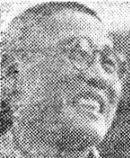
|
One unit has been fighting without interruption, since October, 1943. The other has been in continuous action since January of this year.
|
That's an almost unprecedented tenure in the line.
In North Africa and Italy, both American and British troops considered 60 consecutive days a long time. And if an emergency kept them there for 90 days, they began to think somebody had forgotten them.
German units, particularly in Italy, were given leave at much shorter intervals. German prisoners who had seen service on the Russian front said they not only were taken out of the line about once a month, but frequently were able to go home from the front.
But the Chinese 38th Division, under Maj. Gen. Sun Li-jen has already seen nine consecutive months of more or less constant fighting; the 22nd, under Maj. Gen Liao Yao-Hsiang, is rounding out its seventh month.
In that time, they've battled their way through more than 300 miles of Burma's mountains, swamps, jungles and rice paddies without relief and few replacements.
For one of the wonders of this stubborn Stilwell campaign is that it's been fought, to borrow a household phrase, on a budget which could make only a minimum allowance for wear and tear. The new Chinese units which had some American training came in aid of the small Yank force in Myitkyina. But they merely took over a different part of the campaign.
The 38th and 22nd, which were the first Chinese divisions to receive American training and equipment, were there when Stilwell gave the starting sign for the re-taking of Northern Burma.
And they're still in there slogging today.
EAC Planes Aid Ground Forces At Myitkyina
Throughout the past week, fighters, bombers and troop carrier units of Maj. Gen. George E. Stratemeyer's Eastern Air Command operated successfully throughout Burma, furnishing close support to ground troops, harassing enemy lines of communication and inflicting damage to Japanese aircraft in the air and on the ground.
On each day, P-40's, P-51's and A-36's of Maj. Gen. Howard C. Davidson's 10th U.S. Air Force bombed and strafed selected targets in the Myitkyina area with good results. In addition, B-25's attached to the Third Tactical Air Force carried out several successful bombing attacks against enemy positions and strongpoints at Myitkyina.
HIT AIRFIELDS
Other 10th Air Force fighters made a number of sweeps against Jap airfields, bombing and strafing hangars, buildings, revetments, and destroying a number of aircraft on the ground.
In the Imphal-Kohima sector, fighter-bombers of the Third Tactical Air Force repeatedly attacked the villages of Ningthoukhong and Kha Chunou, inflicting heavy damage. Throughout the week, fighters concentrated on Japanese motor transports. A large number of trucks, staff cars, tanks and tankettes were destroyed. Successful attacks were also carried out against bridges and troop concentrations on the Tiddim Road.
RAILROADS BOMBED
On July 9, 11, and 12, twin-engine, long-range RAF fighters (Beaufighters) and USAAF P-38's attached to the Tactical Air Force inflicted severe damage to enemy lines of communication in central Burma. Many direct hits were scored on railroad tracks, locomotives, rolling stock, steamers, barges and other river craft. A number of bridges were knocked out.
During the week, in the air and on the ground, Eastern Air Command aircraft destroyed 11 enemy planes, probably destroyed five, and damaged seven.
14,000 NIPS KILLED IN HENGYANG DRIVE
CHUNGKING - The Japanese are continuing strong efforts to dislodge Chinese defenders along the Canton-Hankow railway, after having received a severe reverse at Hengyang.
According to the Chinese High Command, more than 14,000 Japs were killed in their initial attack on Hengyang city, which the Chinese state id still in their hands. At the same time, Chinese spokesmen acknowledged that enemy forces are attacking Yingtak, 70 miles north of Canton. Yingtak lies on the railway, some 225 miles south of the current fighting around Hengyang.
A second assault on Hengyang was rolled back this week after the invaders had penetrated inside the city.
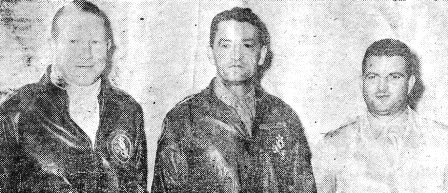 WILLIAMSON, CHENNAULT, McDONALD
WILLIAMSON, CHENNAULT, McDONALDA dream ripened into fulfillment. |
14TH AIR FORCE HQ. - Ten years ago, crowds attending the annual National Air Races at Cleveland and numerous other meets throughout the nation were thrilled by the greatest combination of precision fliers the world had then produced.
Three Army Air Corps pilots, known as "The Men of the Flying Trapeze," provided the exploits which often topped any show an ambitious meet producer could present. From 1932 through 1935, the bi-planed Boeing P-12 was considered something in airplanes. They were maneuverable, fast, according to the era and this trio of youngsters could do everything but make 'em talk.
Captain Dreams Fighter Tactics
They were led by a young officer, Capt. Claire L. Chennault, who dreamed fighter tactics. To him, these shows were not mere exhibitions; they were demonstrations of what could be done with these planes. His assistants were Sgts. Luke Williamson and William McDonald, although at exhibitions the sergeants were placed on their active reserve status of second lieutenants.
Now, 10 years later, the theories advanced by the young captain of the Air Corps are bearing results on a grand scale. And, strangest of all, the "Three Men on the Flying Trapeze" are serving the United Nations on the same stamping ground - China.
The captain is now Maj. Gen. Claire L. Chennault, commander of the 14th Air Force. Lt. Col. Luke Williamson is commanding officer of the 14th Transport Section, and Bill McDonald is a captain flying a huge C-47 transport for the China National Aviation Corp.
Smallest - But, Oh, My
Under the leadership of Chennault, the planes of the smallest of all our Air Forces harasses and smashes relentlessly at the Japs. They support the ground forces of the fighting Chinese, deep in the hills where supplies are hard to come by and where Lend-Lease is unknown. In all sorts of weather, thee pilots, both Yank and Chinese, continue the job of keeping China for the Chinese, strafing and bombing enemy columns, making sea sweeps, blasting military installations.
The achievements of the Flying Tigers, both past and present, are directly traceable to ideas that the young flying captain of "The Men on the Flying Trapeze" dreamed of 10 years ago. Chennault knew that the maneuvers he was showing to an awe-stricken audience could be advantageously applied to actual combat.
Often when there is a lull, which isn't frequent, Chennault, Williamson and McDonald get together for hangar sessions. And as they skillfully ply their chopsticks upon a succulent dish of sweet and sour pork, the discuss "the good old days of the air shows."
UNARMED P-38 OVER JAPAN
PHOTOGRAPHED ISLAND LAST OCTOBER
CHINA - With the award of a Distinguished Flying Cross, the dramatic story of a pilot who took aerial reconnaissance photographs over Japan in an unarmed P-38 last October was disclosed this week.
He is Capt. Winfred A. Sordelett, 24, Hopewell, Va., a former post office clerk.
Sordelett made the daring sweep over the enemy's homeland and returned to China with precious film and weather data. Among the places he flew over was the big naval base of Sasebo, which was bombed by B-29 Super-Forts on July 7.
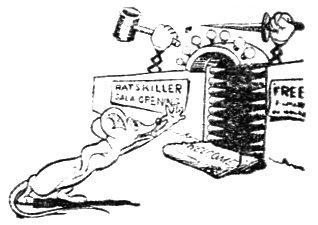
|
SUPER TRAP FOR RATS
ALONG THE LEDO ROAD - "Build a good mouse trap and the world will beat a path to your door."
Sgt. Melvin W. Pfeiffer, member of an Aviation Engineering Battalion on the Ledo Road in Northern Burma, decided to go this old adage one better. He built a super-duper RAT trap which may revolutionize all such contrivances for centuries to come.
Tired of being taunted by a sneering rodent that bravely appeared at every turn, Pfeiffer, who is an inventor at heart, planned a painless, effective way to snare the snickering "varmint."
The result of his labors is a modern, electrical device consisting of an 8" x 10" sheet metal plate with a wooden block mounted in the center and a 4" x 4" metal piece attached to this.
By means of radio clips, one electrical pole is carried to the base plate and the other to the top piece. A sliver of delicious K ration cheese is temptingly placed on the upper grid.
All the rat has to do is place his rear feet on the base plate and attempt to nibble the cheese. Presto - he closes the circuit and is electrocuted with the finesse of a Sing Sing chair.
Only catch is this: The wise-acre rat has beaten a wide path from Pfeiffer's door. Rumor has it, he took one look at the gadget, thumbed his wiggling nose and moved to another tent. - By C. M. BUCHANAN.
By Cabin "40" Once we were happy Now we're forlorn: We wish to Heaven We'd never been born. We read the pamphlets Our hair has turned gray. And now this is all we can say: This trip we are taking for Army morale Is giving us quite a surprise; We never had figured on a 40-day ride When we made all those tearful goodbyes. Chorus Oh, we sail through the ocean With the greatest of ease Onward toward India, the land of disease Get out your flashlights and look in your shoes And don't drink even the booze |
|
We looked forward to India The home of romance But all we'll get is Our pants full of ants We'll shake from our shimmies Scorpions and lice When either would really suffice This land we're approaching is mystic Stay away from the temples and cows Be friendly and take a bath daily You'll be floored by the bugs you can house. Chorus Oh, we sail through the ocean With the greatest of ease Onward toward India, the land of disease Oh we've often seen snakes That really weren't there But we'll soon find them curled in our hair. Avoid open sewers when going for a swim Remember that bugs lurk in corners so dim Sleep in your own house, under a screen And never stark naked be seen. |
|
The dangers we'll find there are many We'll swell and we'll itch and we'll sneeze We'll suffer from zaws, plague and dum dum We'll either perspire or freeze. Chorus Oh, we sail through the ocean With the greatest of ease Onward toward India, the land of disease Our mission is noble Our job we don't shirk. And we hope that those damn shots will work. By:- Martha Ann Goodwin Judy Fitch Sally Edge Audrey Edmonds Doris M. Farr Lewise R. Gordon Doris L. Ewing Jean Hanson Cappy Freese AMERICAN RED CROSS |
Dog's Life For 'Roger'
AIR COMMANDOS' MASCOT
CBI AIR COMMANDO UNIT - "Roger," official mascot of the Air Commandos, is a large chow with a possible smattering of Alaskan husky. During the past seven months he has accumulated more than 600 flying hours, over four continents, has participated in at least 100 combat missions over Japanese-occupied territory, and spent four days on one of the air strips behind the enemy lines during last spring's airborne invasion of Burma.
|
Roger joined the Commandos last December at Patterson Field, Ohio, just before one of Col. Phillip Cochran's C-47's was about to take off for the long journey to India. Roger strolled up, made friends with the crew, and climbed in. From that time on, he has considered himself the personal property of pilot Lt. Frank Huxley, of Ripley, N.Y.
CONDUCT EXEMPLARY
Roger's conduct was exemplary on the long flights to South America, across the South Atlantic to Africa, and finally to India. His first view of India was at a West India port, where he emerged from his airplane promptly to become embroiled in mortal combat with four local dogs. He emerged with the situation well in hand.
Since then, Roger has visited various bases in India. He put in several days at a maneuver area where the Air Commandos first became acquainted with the Chindits, whom they were later to transport into Jap-held Burma. Finally, he arrived at the advance base in Assam from where these operations were to proceed.
By this time Roger had developed an uncanny sense of when Huxley's plane was about to take off and invariably the dog was on hand and waiting even before the arrival of the crew chief.
ACTIVE DURING LANDINGS
On the night of the first airborne invasion, Roger flew into Broadway. Later he visited Chowringhee, Aberdeen, and every other strip operated by the Chindits and the Air Commando unit in Burma. On several successive nights, he flew at least two combat missions, jumping from his own ship into another as it was taking off.
During one phase of the invasion, Roger's position as mascot of the group was seriously threatened by "Broadway Bill," a disreputable canine character out of Burma, who looked like an English bull terrier but whose antecedents were lost in the mysteries of the Orient. After a few brief but bitter battles, however, Broadway Bill joined another outfit where he could reigned unopposed.
Roger hates water, but, twice a week, he marches off to get his bath with all the discipline of a good soldier. Right now Roger is slightly war-weary, and may have to go to Kashmir for a few days to recuperate with his master at the rest camp there.
'JUST ANOTHER DAY'
By Cpl. C. M. BUCHANAN Roundup Field Correspondent
ALONG THE LEDO ROAD - The husky, laughing soldiers leaped from their truck, attached safety belts and climbers and ascended the pole with rhythmic grace.
It was "just another day" for these men of a Negro Signal Corps Construction Battalion busy extending vital communications lines along the Ledo Road.
But black-haired, barefoot Kachins, soberly watching the crew, recognized the unmistakable sign of a land being freed from Japanese treachery and oppression.
It meant that telephone and telegraph communications were being carried forward to help Lt. Gen. Joseph W. Stilwell's Chinese and American troops push back the invading Japs, so that the Ledo Road could be connected with the old Burma Road, to open a vital line to blockaded China.
FACING MONSOON
Constructing a five circuit open wire lead, plus auxiliary lines, these Negro soldiers are facing the fury of the Burma monsoon, resolved to do the job ahead of schedule, despite all obstacles, including enervating heat, breath-taking humidity, tough, thick, animal-infested jungle, snakes, insects and endless, pouring, maddening rains.
Tall, clear-eyed M/Sgt. Lionel A. Boutte, chief line foreman, is proud of his men and the manner in which they have performed their assignments.
At one spot, poles had to be carried 550 feet from the road into solid jungle.
leeches attached themselves to the workers by the hundreds. It became a painful job to burn them off with cigarettes to prevent infection.
After a path had been hacked through the vines and brush, the men cleverly jockeyed their truck into position so that the poles could be winched into place.
TRAPEZE ARTIST?
The work is not without humor, however. Boutte recounted how T/Sgt. Malcious Milton Brady, while splicing two lines, cut off from the pole and dangles from the braces. The soldier working under him looked up and exclaimed, "So, you're the man of the flying trapeze."
These Negro Signal Corps soldiers are versatile. A bridge along the Ledo Road was being battered by logs and debris brought downstream by the rain-swollen torrent. Only a handful of Engineering troops were immediately available.
The Signal Corps men pitched in and fought the raging waters for 12 hours, pulling trees from the underpinning of the bridge. Some men risked their lives by diving under the swiftly-moving waters to hook a winch line to huge logs that were clogging the torrential stream.
|
Their temporary engineering job well done, the Signal Construction group was highly praised by the Engineering officers.
Boutte had a narrow escape recently, clearing jungle for the erection of some poles. After cutting three and a half miles through thick forest, a large tree, six feet in diameter and 55 feet high, with dozens of clinging, foot-thick vines, was encountered.
The cluster of hanging vegetation blocked the path. It was necessary to cut it at the top. Boutte scaled the tree with the aid of the vines, sliced them loose, but found it difficult to come down the tree after they had been removed.
He decided to emulate Tarzan. Reaching over, he tested some vines on the other side and attempted to swing to the ground. They broke and he tumbled head first. His fall was broken by a cluster beneath which he grabbed just in time to ease himself to the ground. "I sat out for a smoke after that," Boutte commented.
The entire job is being done for permanency, in contrast to the enemy temporary communications strung by the retreating Japs. A creosoting plant has been erected where all poles are butt treated by men of the unit.
Another regular function of the outfit is to constantly police the lines to safeguard against sabotage, sneak patrols and normal hazards such as washouts and falling trees.
These soldiers are proving to be ambassadors of good will as they give cigarettes and knick knacks to the Kachins of Northern Burma.
The are proud of their equipment and have high praise for the manner in which it has stood up under such grueling conditions. Their training has proved valuable, but the jungle is more terrible than most ever imagined.
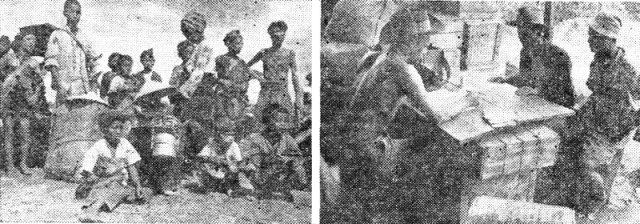 With the assault upon Myitkyina, Lt. Gen. Joseph W. Stilwell inherited a responsibility: That of feeding the Burmese
inhabitants of the besieged town. Left, a graphic picture of part of the exodus. Right, Cpl. Leslie C.
Wilson scans ration slip of a refugee who has come to draw his family allowance from the Army warehouse.
With the assault upon Myitkyina, Lt. Gen. Joseph W. Stilwell inherited a responsibility: That of feeding the Burmese
inhabitants of the besieged town. Left, a graphic picture of part of the exodus. Right, Cpl. Leslie C.
Wilson scans ration slip of a refugee who has come to draw his family allowance from the Army warehouse.
|
U.S. GIVES FIGURES ON CBI LEND-LEASE
WASHINGTON - Lend-Lease supplies amounting to almost $1,400,000,000 have been shipped by the United States to the China-Burma-India Theater from the war's start to May 1, 1944, Foreign Economic Administrator Leo Cowley announced this week.
Over $217,000,000 worth of war materials were shipped to Lt. Gen. Joseph W. Stilwell for transfer to Chinese forces, including ordnance, tanks and vehicles.
14TH AIR FORCE DESTROYS 44 JAP PLANES
CHINA - The Japanese air force, battling vainly to halt the marauding fighters and bombers of the 14th Air Force, lost 44 airplanes in China this week, with 15 more probably destroyed and 16 damaged.
Eight attempted interceptions by Jap fighters on July 10, 11, and 12, cost the Japs a dozen aircraft. Then B-24's bombed the Nip hornet's nest at Pailuchi on the night of July 13, and next day 14th Air Force fighters, in a lightning surprise thrust, caught dozens of the enemy on the ground there, destroying 27 planes with 10 more probable. There was no further interception during the week.
American and Chinese-American Composite Wing bombers and fighter-bombers, meanwhile, sent smoke and flame billowing skywards from numerous targets in China and Burma, destroying gasoline, munitions and supply dumps in crippling blows at the Jap armies.
Air support roared into high gear on the Salween front, where B-25's struck daily at Tengchung, breaching the wall of the fortress town, and also hit Lungling and Mangshih. Troop Carrier planes showered over 250 tons of supplies to the attacking Chinese armies.
In Central China, a large flight of B-25's hit Hankow and Wuchang airdromes by night, starting fires. Other formations struck at Jap-held airfields at Hengyang and Siangtan.
Attacks along the roads and rivers in the Hengyang-Tungting Lake area destroyed more than 150 river craft and many vehicles, and killed over 400 Jap troops. Targets around Canton and in northern Indo-China were also hit during the week by the 14th's wide-ranging planes.
Six American planes were lost in all operations, but three pilots are reported safe.
11th Army Prepares Assault On Lungling
|
In the Tengchung area the 20th Group Army is engaged in close action with the Japanese. Parts of the city itself are aflame after bombing by the 14th Air Force which scored direct hits on ammunition stores.
The 11th is now west of the Burma Road and in a strong striking position. Elements of the 11th and 20th have made contact at Chiaotoukai, after troops from the latter crossed the Shweli at that point.
JAPS ENTRENCHED
The Japs are still strongly entrenched to the north of Lungling, for a stretch of two miles along the road between that city and Tengchung. But, past the two-mile mark, the Chinese armies hold the entire road, except for small, isolated parties of Japs who haven't yet been wiped out.
In scattered actions along this wide-fought Salween front, the Japanese garrison at Pingka, near the southernmost end of the Chinese line, has been completely cut off. The enemy is attempting to move in relieving troops but they were being engaged by the Chinese.
ATTACK FAILS
Elsewhere in the southern sector, a Nip force attacked a Chinese position between Mangshih and Hsiangtha early in the week, but this attack was pushed back.
The strongly-held walls of Tengchung present the most formidable obstacle to the 20th forces. One partial breach was made in the north wall by a raid by 14th Air Force B-25's.
QUESTION AND ANSWER DEPARTMENT
ROUNDUP PUTS FINGER ON PULSE OF READERS IN CBI THEATER
An unkind suspicion has recently been voiced that the Roundup does not have its figurative finger on the public pulse. We quote from a letter found impaled with a dagger in the back of the editor's easy chair: "Why don't you guys get your finger, etc., (several words omitted here), and on the pulse of CBI troops?"
So gives with a question and answer department for puzzled Pfc.'s and T/4's with troubles. Are you jungle jerky? Has your first sergeant been cold and aloof lately? Are your shoes too tight? Carve your woes on a roll of split bamboo and mail to T/7 Stanilaus Dillberry, T/S Editor, c/o Roundup.
The following are some of the legible letters received this week, delivered in the end of a cleft stick by a sad-eyed Yogi with a dirty dhoti:
Q.-Dear Editor: Six months ago I was sent to China with a Signal Corps pigeon unit, but our operations have been a failure. The pigeons have a critical altitude of 12,500 feet and conk out trying to carry messages across The Hump. Do you think we will be sent back to the U.S.? - Cpl. Homer.
A.-No. The Army never admits defeat. S.O.S. informs us you will shortly receive a supply of Masks, Oxygen, Pigeon, M-2, newly developed in America, which will add 5,000 feet to the birds' service ceiling. Remember the motto of the Pigeon Corps and pigeons in general: "Straight to the Mark."
Q.-Dear Roundup: When I joined the Army, my best friend, Harry, who is 4-F, promised to keep an eye on my girlfriend, Rosie, for me. Harry doesn't like women, however, and I was afraid they would quarrel. But two months ago Rosie wrote me to say Harry is a perfect gentleman, never swears when he cuts himself shaving and dutifully wears the lounging robe I sent him last Christmas, although it is two sizes too large. Rosie says she still loves me, and is so glad I have such nice friends. Don't you think I'm lucky to have a girl like that? - Pvt. Lives.
A.-Are you kidding?
Q.-Roundup: Last week I caught hell from a colonel because I saluted him while he was riding a bike. As he went to return the salute, he fell into the ditch. Two days later, I caught hell from a second lieutenant for not saluting him, even though he was also on a bicycle. What am I supposed to do? - Frustrated.
A.-Salute 'em all, dear Frustrated, and let the bodies fall where they may.
Q.-Say, You:-Uniform regulations at New Delhi don't allow me to wear the bush jackets I bought and was allowed to wear last year. Neither do they permit me to wear the Pershing-type cap. I haven't my barracks bags, as they are still catching up with me. If I go out in a bush jacket or my Pershing cap the MP's will pick me up and if I go out without them they'll also pick me up. Do you know the answer? - Worried.
A.-Join the Navy or get out of town.
The C.B.I. Roundup is a weekly newspaper of the United States Army Forces, published by and for the men in China, Burma, and India, from news and pictures supplied by staff members, soldier correspondents, the United Press, OWI, and Army News Service. The Roundup is published Thursday of each week and is printed by The Statesman in New Delhi, India. Editorial matter should be sent directly to Capt. Floyd Walter, Headquarters, U.S.A.F., C.B.I., New Delhi, and should arrive not later than Sunday in order to make that week's issue. Pictures must arrive by Saturday and must be negatives or enlargements. Stories should contain full name and organization of sender.

JULY 20, 1944
Original issue of C.B.I. Roundup shared by Ruth Canney, widow of CBI veteran John Canney.
Copyright © 2007 Carl Warren Weidenburner
TOP OF PAGE PRINT THIS PAGE ABOUT THIS PAGE SEND COMMENTS
PREVIOUS ISSUE CLOSE THIS WINDOW NEXT ISSUE
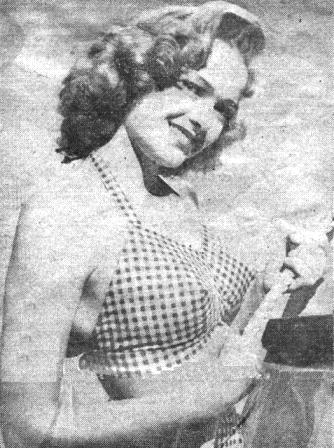 Lovely Jane Nigh is soooooo sad. She has never been made queen of any G.I. outfit, nor has she ever had a
request for pinup pictures. Frankly, the Roundup doesn't pretend to know the answer to this one.
Lovely Jane Nigh is soooooo sad. She has never been made queen of any G.I. outfit, nor has she ever had a
request for pinup pictures. Frankly, the Roundup doesn't pretend to know the answer to this one.
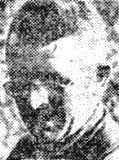
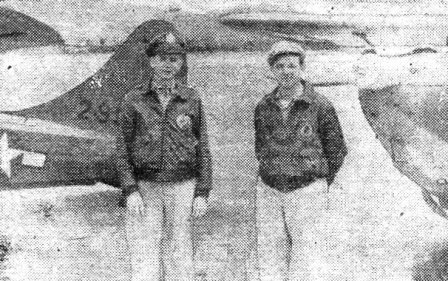
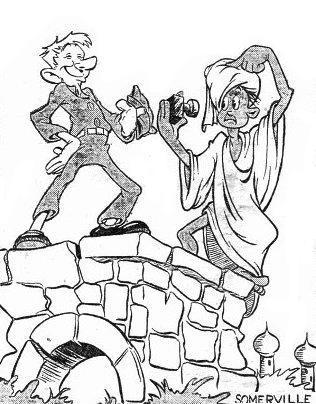 "THE FOLKS WILL LOVE THIS SHOT OF ME."
"THE FOLKS WILL LOVE THIS SHOT OF ME."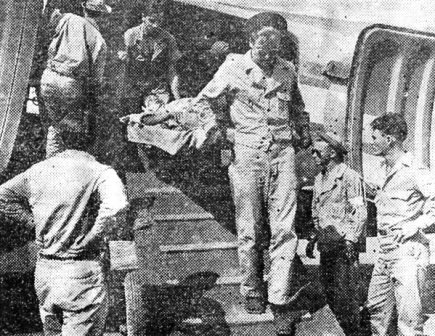 A wounded Chinese soldier is removed from a plane at a clearing station somewhere in India by members of an
Air Evacuation unit.
A wounded Chinese soldier is removed from a plane at a clearing station somewhere in India by members of an
Air Evacuation unit.
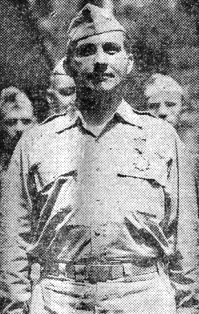 Brig. Gen. Thomas S. Timberman, newly-appointed Deputy Chief of Staff, wears the Legion of Merit presented by
Lt. Gen. Joseph W. Stilwell at Chungking. The decoration was awarded Timberman for "outstanding service" as
Chief of the Asiatic Section in the Operations Division of the War Department General Staff.
Brig. Gen. Thomas S. Timberman, newly-appointed Deputy Chief of Staff, wears the Legion of Merit presented by
Lt. Gen. Joseph W. Stilwell at Chungking. The decoration was awarded Timberman for "outstanding service" as
Chief of the Asiatic Section in the Operations Division of the War Department General Staff.

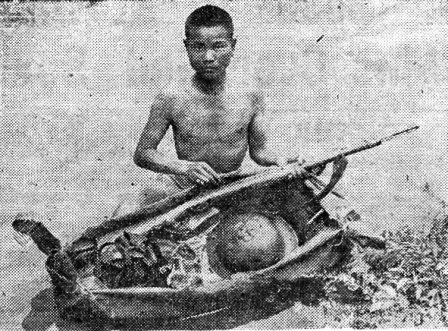 There's a trick to getting one's equipment in dry condition to the opposite side of a river and an American
Infantry Training Center in China has taught it to soldiers like Sgt. Yung. The sergeant's improvised
raft is composed of his raincoat and two bamboo strips. He carries complete sniper's equipment: rifle,
bayonet, helmet, cartridge belt, axe, knife, length of rope and all his clothing.
There's a trick to getting one's equipment in dry condition to the opposite side of a river and an American
Infantry Training Center in China has taught it to soldiers like Sgt. Yung. The sergeant's improvised
raft is composed of his raincoat and two bamboo strips. He carries complete sniper's equipment: rifle,
bayonet, helmet, cartridge belt, axe, knife, length of rope and all his clothing.

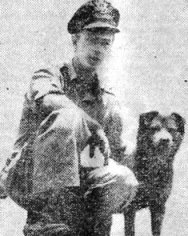 "Roger" and his master, Lt. Frank Huxley, pose of the wing of their C-47.
"Roger" and his master, Lt. Frank Huxley, pose of the wing of their C-47.
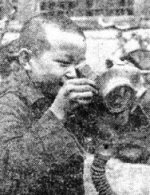 A Chinese youngster, too young to fight, tries on the face piece of a captured Japanese gas mask, part of equipment
captured by Chinese armies in their drive against the Japs in the Salween River campaign.
A Chinese youngster, too young to fight, tries on the face piece of a captured Japanese gas mask, part of equipment
captured by Chinese armies in their drive against the Japs in the Salween River campaign.